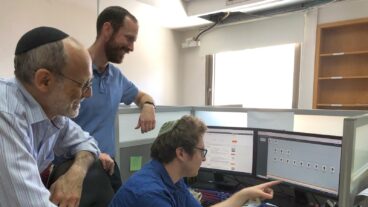Israeli math textbooks will focus ‘on the content to be learned, rather than how it should be taught.’Ron Aharoni, who teaches mathematics at the Technion-Israel Institute of Technology in Haifa, Israel, took an excursion into teaching elementary school. “What surprised me the most,” he says, “is that I learned mathematics. Actually, a lot of it.”
Aharoni’s article is in the fall issue of American Educator, a quarterly magazine published by the American Federation of Teachers along with several others on the general topic of helping children to learn mathematics. Useful for teachers, but also for parents who might want some hints about how to talk to their very young children about math.
What he didn’t understand when he began teaching young children, Aharoni says, is that concepts that adults understand as a whole, “are in fact constructed from many small components, built one on top of the other, and that none of them can be skipped.” For example, children in a first-grade glass were asked to tell “arithmetical stories” about a picture of three green and two red apples, one using addition and one subtraction. Addition was easy; if you have three green apples and two red ones, how many apples do you have?
But a subtraction story was a stumper. Finally one child ventured, “I had five apples. I ate two. How many do I have left?” That’s a story, but it’s not about that picture.
Eventually, Aharoni said, he realized that the children had skipped a stage; they didn’t realize that subtraction has more than one meaning.
It’s not only about taking things away, but also about comparing things. If you have five apples, and two of them are red, how many are green? That’s 5 – 2 = 3. Or how many more green apples are there than red ones? That is 3 – 2 = 1.
The concept might seem obvious, but not to 6-year-olds. When they are explicitly taught about the various meanings of subtraction, the problem is easy for them; if they aren’t, it is hard.
Aharoni’s experience teaching in elementary school has led him to become involved in an effort to replace the Israeli math curriculum that was imported from the US in the “new math” decade of the 1960s, “in a most strange and extreme form” called “structuralism.”
As Aharoni describes one illustration, “A facelike picture into which three numbers are put, two in the places of the eyes and one at the mouth, was supposed to teach children when to add and when to subtract. If the two numbers were at the eyes, and the missing number was at the mouth, it was an addition problem; if one was at an eye and another at the mouth, it was a subtraction problem.”
As a consequence of inflicting this idiocy on Israeli children for several decades, “Israel dropped from first in the world in 1964 to 29th place in 1999” on international assessments. So much for people who believe that curriculums don’t matter, only teachers do.
Aharoni notes one possible explanation, offered by two Australian researchers, for why so many American and British education reforms have been taken up in other countries, even after they’ve failed miserably where they originated. Foreign graduate students come to the US or the UK, and when they go back home they implement whatever was the fad of the year when they earned their doctorates.
A nonprofit organization, the Israeli Foundation for Math Achievement for All, has persuaded the Israeli Ministry of Education to drop the structuralist textbooks and replace them with a curriculum that focuses “on the content to be learned, rather than how it should be taught.”
Also, they are working to develop a math curriculum using translations of math textbooks from Singapore, which is at the top of the international rankings of mathematics achievement. (Singapore math books are also available in English, and popular with home-schoolers). The organization offers regular professional development.
“We find the teachers learn a lot of mathematics along with the children – just as I did,” Aharoni says.
What math should be taught in elementary school? “The embarrassingly simple answer is: the four basic operations – addition, subtraction, multiplication and division.” Even more basic is the idea of forming a unit on which the operations are performed, which underlies the idea of place value in the decimal system.
These ideas are all so familiar that adults never think about them consciously at all, yet mathematically they are deep. The first rigorously axiomatic description of arithmetic is scarcely a century old, while axiomatic geometry goes back to Euclid (though Euclid’s axioms had a number of holes that needed patching). Even if you remember how to add or divide fractions, could you explain why you do it that way? And exactly what is a fraction, anyway?
The current trend in education, Aharoni says, is “to make children happy” so they won’t suffer math anxiety. “My experience is that children are happiest when they truly understand the principles of mathematics,” he says, “not when we make believe that they do.”
(Originally appeared in the Rocky Mountain News)












